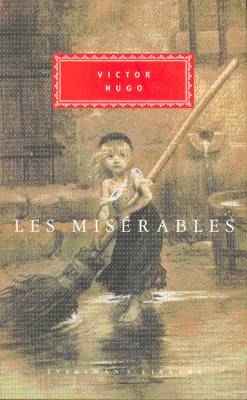Les Miserables

Editorial Everyman's Library
Fecha de edición mayo 1998 · Edición nº 1
Idioma inglés
EAN 9781857152395
1472 páginas
Libro
encuadernado en tapa dura con sobrecubierta
Resumen del libro
Tolstoy is said to have called Les Miserables the greatest novel ever written, and it exerted a powerful influence on the creation of War and Peace. At one level a detective story in which the relentless Inspector Javert obsessively pursues the escaped convict Jean Valjean, culminating in a dramatic chase through the sewers of Paris, at another level Hugo's masterpiece is a drama of crime, punishment and rehabilitation set against a panoramic description of French society in the years after Napoleon's fall from power. But this book is also about the metaphysical struggle between good and evil in the soul of every man and every community.
Coloured by Hugo's distinctive philosophy, it is a plea for social justice, political enlightenment and personal charity which continues to speak with the undiminished authority more than a century after its first appearance.
Biografía del autor
x{0026}lt;P x{0026}lt;B Victor Hugox{0026}lt;/B (1802-1885) nació en Besançon, Francia. Educado en escuelas privadas de París, empezó a escribir siendo muy joven. Poeta, novelista y dramaturgo, llevó a sus obras su espíritu inconformista, que sazonó con grandes dosis de sentimentalismo y anécdotas históricas. En sus obras, exponentes máximos del romanticismo literario, siempre volcó su ideologíaliberal, que le obligó a exiliarse de su país en más de una ocasión. Tras el volumen de poesía x{0026}lt;I Odas y poesías diversasx{0026}lt;/I (1822), las novelas x{0026}lt;I Han de Islandiax{0026}lt;/I (1823) y x{0026}lt;I Bug-Jargalx{0026}lt;/I (1824), y los poemas de x{0026}lt;I Odas y baladasx{0026}lt;/I (1826), escribió x{0026}lt;I Cromwellx{0026}lt;/I (1827), extenso drama histórico, y x{0026}lt;I Marion de Lormex{0026}lt;/I (1829), obra teatral censuradapor ser demasiado liberal. Pero no fue hasta 1830, con la publicación y el estreno de x{0026}lt;I Hernanix{0026}lt;/I , posteriormente adaptada por Verdi, cuando logró el reconocimiento del público y de la crítica. A x{0026}lt;I Hernani x{0026}lt;/I siguieron la novela x{0026}lt;I Notre-Dame de Parísx{0026}lt;/I (1831), la obra teatral x{0026}lt;I El rey sediviertex{0026}lt;/I (1832, adaptada por Verdi en x{0026}lt;I Rigolettox{0026}lt;/I ), x{0026}lt;I Lucrecia Borgiax{0026}lt;/I (1833), x{0026}lt;I Claude Gueuxx{0026}lt;/I (1834), x{0026}lt;I Ruy Blasx{0026}lt;/I (1838) y x{0026}lt;I Les Burgravesx{0026}lt;/I (1843), también obra teatral, que le supusieron su ingreso en la Academia Francesa en 1841. Durante el Segundo Imperio emigró a Bélgica, donde escribió la sátira x{0026}lt;I Napoleón el pequeñox{0026}lt;/I (1852), el poema épico x{0026}lt;I La leyenda de los siglosx{0026}lt;/I (1859-1883) y terminó la que sería su obra más extensa y famosa, x{0026}lt;I Los miserablesx{0026}lt;/I (1862). Regresó a Francia en 1870, donde siguió publicando: x{0026}lt;I El noventa y tresx{0026}lt;/I (1874) y x{0026}lt;I El arte de ser abuelox{0026}lt;/I (1877). Murió en París, y sus restos fueron expuestos en el Arco de Triunfo y luego trasladados al Panteón, donde fue sepultado junto a las mayores celebridades francesas.x{0026}lt;/P








